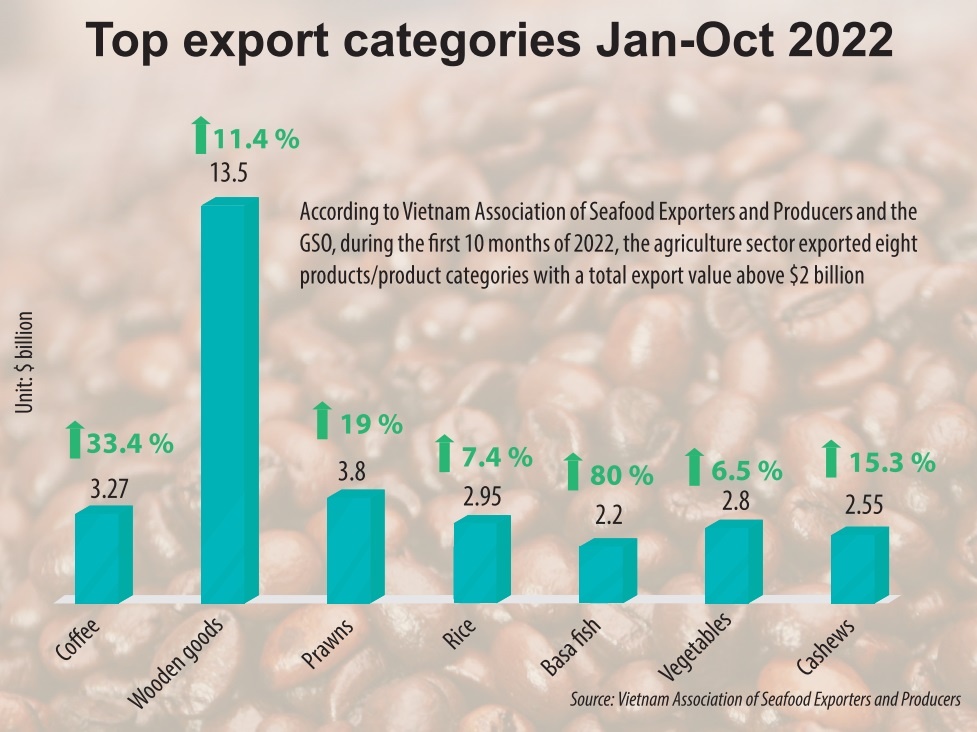Sharp export rise backs up agricultural trade surplus
General Statistics Office (GSO) reported that Vietnam’s total agro-forestry-fishery export-import turnover in the first 10 months of this year topped $82.1 billion, an increase of 10.2 per cent over the same period in 2021.
 |
Exports reached $44.9 billion, up 14.1 per cent, and imports surpassed $37.2 billion, an increase of 5.8 per cent. The sector’s trade surplus stood at $7.7 billion, up 83.7 per cent on-year, while that of the whole economy hit $9.4 billion.
So far this year, agricultural exports continue to have a substantial stimulative effect on the economy, despite numerous fluctuations in the commodity market, transportation issues, and high production expenses resulting from the nearly 50 per cent increase in oil and petrol prices since the beginning of the year.
Deputy Minister of Agriculture and Rural Development Phung Duc Tien explained the sharp increase in agricultural exports, “The drought in China affected production, which is an opportunity for Vietnamese agricultural products to be exported to this market. In addition, inflation in Europe, the war in Ukraine, and global warming has exacerbated the issue of food security.”
However, the agro-forestry-fishery sector’s export turnover is seeing an expansion of billion-dollar sectors such as seafood, rice, and coffee. Moreover, each business and industry has made timely and adaptive adjustments to market fluctuations.
Setting a goal of $10 billion for 2022, after 10 months, seafood exports have already brought in $9.4 billion, an increase of 32.7 per cent compared to the same time in 2021. Monthly seafood exports have topped $1 billion for several consecutive months. Recent orders have decreased but have still exceeded $900 million per month.
Le Hang, director of communications for the Vietnam Association of Seafood Exporters and Producers, said, “This year is one of many changes, but it has been altered thanks to the efforts of Vietnamese seafood businesses. The possibility of exceeding the goal is nearly assured if we can turn obstacles into opportunities by capitalising on free trade advances and market demand to increase exports.”
Vietnam’s seafood sales will surpass $10 billion by the end of November, a record for the country’s seafood sector after more than 20 years in the global market. Seafood sales are anticipated to surpass $11.4 billion overall for the year.
In the category of exports above $3 billion per year, coffee has also exceeded its goals thus far. In just 10 months, coffee exports generated $3.2 billion, an increase of 33.4 per cent in value and 10 per cent in volume compared to the same time last year. The total revenue for 2022 may exceed $3.8 billion.
This year, the rice sector expects to sell 6.3 million tonnes worth $3.3 billion, but the potential to hit 6.5 million tonnes and $3.5 billion will soon be realised as approximately 6.1 million tonnes have been sold for $2.95 billion over the last 10 months, an increase of 17.2 per cent and 7.4 per cent, respectively.
Vietnamese seafood was also in great demand this year. According to the Ministry of Agriculture and Rural Development, rice exports have exceeded 700,000 tonnes and more than $340 million each month for the last two months.
The Vietnam Food Association has projected that rice exports for 2022 will reach 6.6-6.7 million tonnes, valued at around $3.6 billion.
The Foreign Trade Agency under the Ministry of Industry and Trade also said that the fruit and vegetable industry has received positive signals, promising to regain its growth momentum, as the Chinese market has reduced quarantine procedures and simultaneously opened the official import door for Vietnam’s durian and passion fruit.
In a bid to improve the quality of agro-forestry-fishery products, the MARD is planning a scheme on the development of circular agriculture to minimise waste and environmental damage and to increase productivity and shorten supply chains.
According to the MARD, circular agriculture will be the key to efficiently managing agricultural resources. It focuses on using minimal amounts of external inputs, closing nutrient loops, regenerating soils, and minimising the impact on the environment. If practiced on a wide scale, circular agriculture can reduce resource requirements and the ecological footprint of agriculture.
 | Agricultural enterprises focus on emissions mitigation Many agricultural enterprises, especially food exporting and processing enterprises, are working to save energy, contributing to meeting the country’s greenhouse gas (GHG) emissions target. |
 | Closing regional links and increasing agricultural values Businesses and experts look forward to the regional supply chain links between producers and consumers, which are deemed crucial to foster the value of Vietnamese agricultural products. |
What the stars mean:
★ Poor ★ ★ Promising ★★★ Good ★★★★ Very good ★★★★★ Exceptional
Related Contents
Latest News
More News
- Businesses ramp up production as year-end orders surge (December 30, 2025 | 10:05)
- Vietjet chairwoman awarded Labour Hero title (December 29, 2025 | 13:06)
- How to unlock ESG value through green innovation (December 29, 2025 | 10:03)
- AI reshapes media and advertising industry (December 29, 2025 | 08:33)
- FPT and GELEX sign deal to develop blockchain tech for global markets (December 29, 2025 | 08:29)
- Vietnam’s GDP forecast to grow by 9 per cent in 2026 (December 29, 2025 | 08:29)
- Women entrepreneurs are key to Vietnam’s economic growth (December 29, 2025 | 08:00)
- Vietnam's top 500 value-creating enterprises announced (December 27, 2025 | 08:00)
- The PAN Group shaping a better future with ESG strategy (December 26, 2025 | 09:00)
- Masan Consumer officially lists on HSX, marking the next phase of value creation (December 25, 2025 | 13:20)

 Tag:
Tag:





















 Mobile Version
Mobile Version